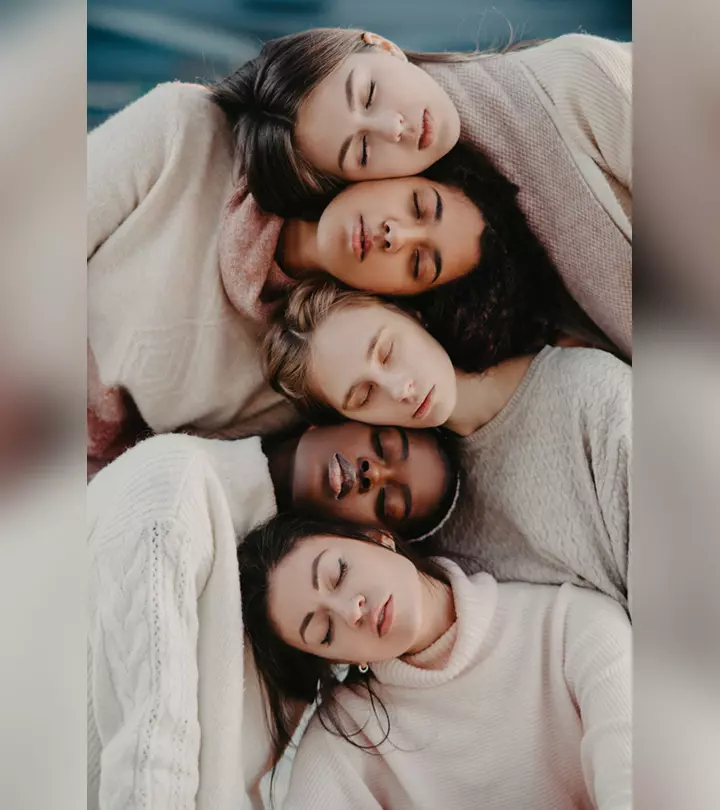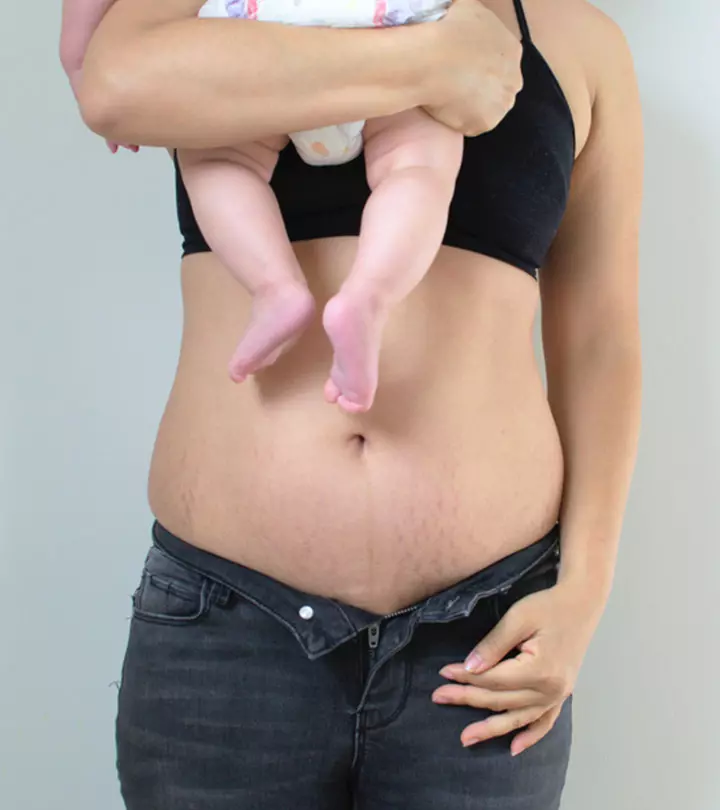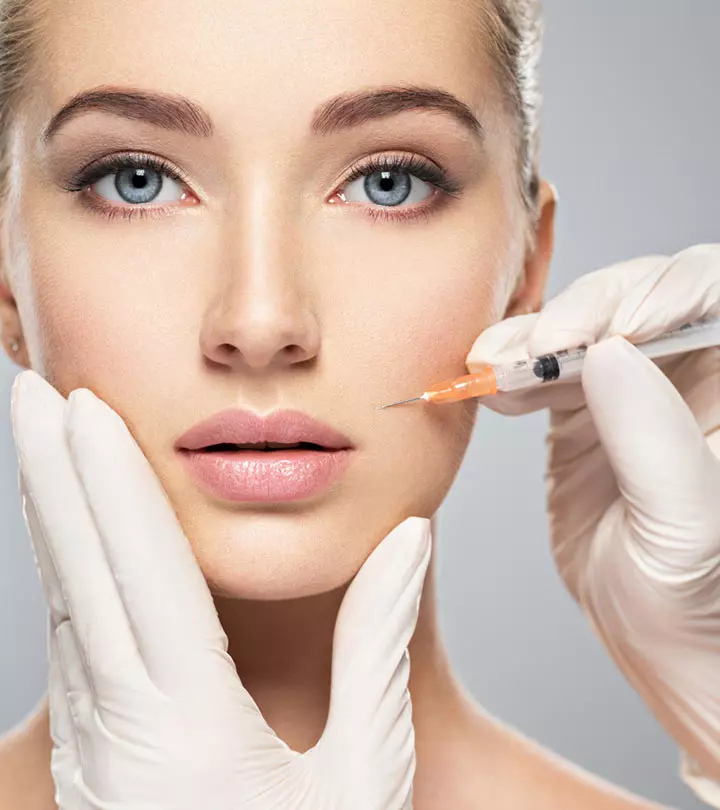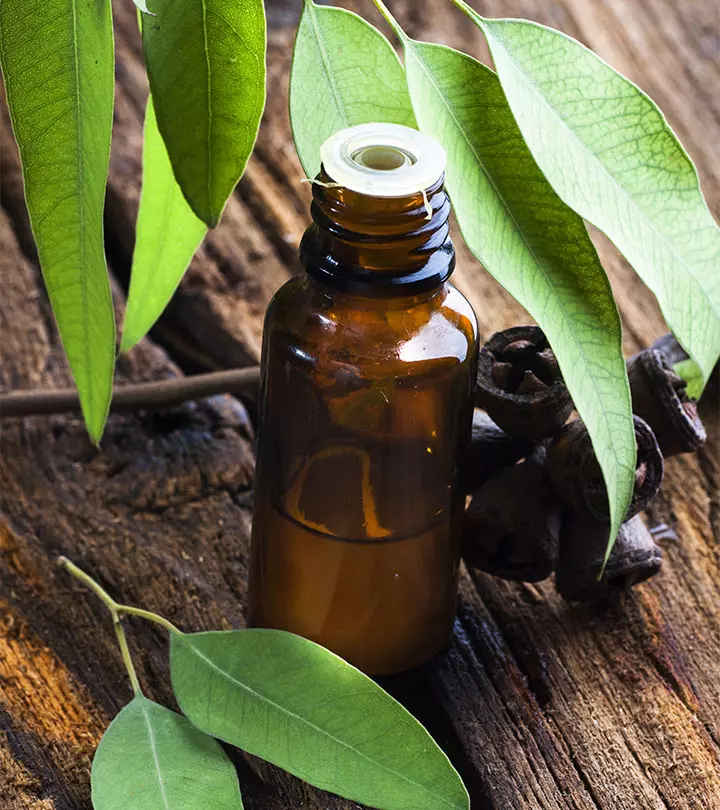How To Find Your Skin Undertone: Cool, Warm, Olive, Or Neutral
Simple tips to help you identify your skin's undertone and nail the right makeup look.

Image: ShutterStock
Choosing the right shade of lipstick or foundation that complements your skin tone can be tough if you do not know your skin undertone. If you are wondering why skin undertone is important and how to find your skin undertone, we can guide you. Most of us prefer to pick lipstick shades or nail polishes based on how the color looks. However, fail to understand that the shades that look lovely on others may not suit us. Understanding your skin undertones will solve half of your makeup woes. And it is not just about makeup; your skin’s undertone also plays a role in what clothing colors and accessories suit you best! So, read on to understand everything about skin undertones.
In This Article
What Is Skin Undertone?
The skin undertone is the hue under your original skin color or the surface tone (also known as the overtone).
When you look in the mirror, your skin may appear ivory, fair, medium, tan, or dark. That’s the color of your skin’s surface. Undertone is the color of your skin that is just beneath that. While you may have the same complexion as anyone else, you may not have the same skin undertone. And this makes all the difference.
Be it foundation, lipstick, or clothing – your skin undertone is the factor that decides which colors or shades will suit you. In the next section, we elaborate on why it is crucial to know your skin’s undertone before delving into how to find your skin undertone.
Key Takeaways
- Use yogurt, turmeric, oatmeal, lemon, and coconut oil as ingredients for homemade body scrubs for skin that is smooth and glowing.
- The excellent combination of coffee, which is rich in antioxidants, and sugar in a homemade scrub works as a hugely effective skin exfoliator.
- Epsom salt helps in getting smooth skin because of its excellent exfoliating properties, and using it to make homemade scrubs can also help reduce soreness.
- Remember to always use natural ingredients and avoid over-exfoliation, which can damage the skin.
Why Does Skin Undertone Matter?
When you know your undertone, you can easily choose clothes and makeup that complement your skin tone.
When choosing a new lipstick, foundation, or dress, you are drawn to its color. You often pick them based on how good they look (at the counter or on someone else). Such “love-at-first-sights” are pretty common for most of us. But when you try it yourself, you see that it doesn’t look right on you. And most of the time, you are confused why this happens. This is because it will not look good on you unless it goes with your skin undertone.
Anna Misztela, a licensed esthetician, says, “Skin undertones—whether warm, cool, or neutral—play a key role in selecting makeup that looks natural and flattering. Foundation and concealer shades should match both the depth and undertone of the skin to avoid looking ashy or orange. Blush and other color cosmetics also look more harmonious when they complement your undertone (e.g., peach tones for warm undertones, rosy shades for cool).”
Diagnosis of your undertone, therefore, comes in handy in such situations. Now, let’s try to find out what your skin undertone is.
Types Of Undertones
Finding your skin undertone can be tricky for some. So, let’s start with understanding the different types of undertones. Traditionally, undertones are divided into three categories.
1. Warm Undertone

2. Cool Undertone

 Trivia
Trivia3. Neutral Undertone

This is for those who have the best of both worlds – a blend of both warm and cool undertones.
However, some people do not belong to any of these three categories. They have an olive undertone. People often tend to confuse the olive undertone with a neutral undertone. But, in reality, the olive undertone is different and has specific characteristics. It has a bit of yellow and greenish-gray hue, and this is why it’s unique.

It is a common misconception that fair-skinned people have a cool skin tone and dark-skinned people have a warm undertone. It can be the other way round too. And that is why the examination of your undertone is crucial before you buy foundation and other makeup products. Keep reading to learn some different ways to find your skin undertone.
How To Find Your Skin Undertone
Identification of your skin is not a difficult task. You can do it at home by observing a few points closely.
1. Observe Your Veins

This technique is the quickest way to determine your skin undertone. See if the veins are visible on your wrist. If they are, see which is the predominant color. There can be several scenarios:
- In the observation, if the veins appear greenish, you have a warm undertone.
- If the veins appear bluish or purple, you have cool undertone skin.
- If you cannot determine the color of your veins or if they match your skin color, it is most likely that you have either neutral or olive undertones.
2. The Jewelry Test
For the analysis of your undertone through this method, hold both golden and silver jewelry against your skin (or lay them on your wrist).
- If the gold jewelry makes you look good, you have warm or olive undertones.
- If rose gold, platinum, or silver jewelry look more flattering on you, you have cooler undertones.
- However, if both gold and silver jewelry looks good on you, you have a neutral undertone.
You can do this evaluation with gold/yellow and silver-colored foils. Hold them against your skin (one by one). Check the reflection of the foils on your skin.
- If your skin glows against golden/yellow foil, you have either a warm or olive undertone.
- If it glows against the silver foil, you have a cool undertone.
- If your skin looks good against both the foils, you have a neutral undertone.
3. Take The Color Test
Hold garments of different colors against your skin for this method. It is better if you wear them and stand in front of a mirror. You have:
- Cool Undertone: If you look good in purple, black, emerald, bright blue, lavender, and pink.
- Warm Undertone: If you look good in olive green, brown, coral, orange, amber, yellow, peach, and similar shades.
- Neutral Undertone: If you look good in almost any hue you wear.
- Olive Undertone: If you look good in green, purple, pink, and almost any color except the pastel shades.
4. Check The Way Your Skin Behaves Under The Sun
For this assessment, observe how the sun affects your skin.
- If you get sunburned easily, you might have a cool undertone. In such cases, the skin often turns pinkish or reddish under the sun.
- If you do not get sunburned easily, but tan a lot, you might have a warm undertone. In such cases, the skin often looks a bit yellowish (if you are fair) and on the olive side (if your skin tone is dark).
5. Check the Skin Behind The Ears
- If the delicate area behind your ears appears yellowish, you have a warm undertone.
- If it is rosy and a bit pinkish, you have a cool undertone.
These methods can give you a better sense of your skin’s undertone, helping you make more informed choices regarding selecting makeup and clothing. Wearing flattering shades of makeup and clothing can make you feel more confident.
Hannah Louise Poston, a YouTuber, explores makeup options for her skin with olive undertones, sharing her recent realization about her undertone and how it has affected her makeup choices. She shares, “I am not an expert because it took me years and I figured mine out kind of by the process of elimination, I was like well if I’m not peach and I’m not golden and yellow, or pink and blue, and what’s left and I am using green color corrector – oh yeah maybe I have an olive undertone (i).”
The difference between the overtone and undertone can get confusing. When purchasing clothing and makeup, you have to consider both. In the next section, we have discussed the difference between skin overtone and undertone.
Overtone Vs. Undertone: What Is The Difference?
The skin undertone is invisible. It is the subtle hue underneath the surface tone or the overtone. On the other hand, the overtone is your skin color – the color that you see when you look at your face in the mirror.
The skin overtone may change (due to tanning or during winters), but the undertone never changes.
 Quick Tip
Quick TipKnowing your undertone and the overtone helps you choose your makeup and clothing. Here is a simple guide to help you make better choices.
How To Pick The Right Foundation For Your Undertone
If you want to know how to find your foundation shade, there are some pointers that can help. Read on!
1. For Cool Undertone
You may have pinkish or reddish surface tones around the T-zone. Pick a foundation that can warm it up a bit. If you are on the fairer side, you can go for a blend of ivory foundation with just a hint of yellow in it. Don’t be afraid to mix your foundations. The yellow tint helps in balancing the pink or red surface tone.
2. For Warm Undertone
If you are fair, your skin may have a peach to golden-beige hue. If you have a deeper skin tone, it appears more like honey or has a golden hue. Go for foundations that have a bit golden or yellow undertone. Try exploring shades that highlight your natural warmth, such as terracotta or golden tones. Many makeup brands now provide a wide variety of options specifically tailored to warm undertones, making it simpler to find a foundation that suits you perfectly.
3. For Neutral Undertone
Choose a foundation that leans subtly towards the golden hue. Avoid anything that makes your skin yellow, golden, pink, or red.
4. For Olive Undertone
People with olive undertones have a very subtle greenish hue, along with natural and warm tones. Just like people with neutral undertones, pick a foundation that has a subtle leaning towards golden. Avoid any foundation shade that turns your skin golden, yellow, cool red, or pink.
When checking your foundation, use a Q-tip to apply it on your cheekbones, near your jawline, and around your nose. Take a mirror and check it under natural light. If the foundation disappears into your skin, that’s the one for you.
Just like how there are many hair colors for olive skin tones, there are multiple makeup shade options too. Most makeup brands now have foundation shade ranges, such as fair, light, beige, neutral, medium, and dark. Makeup for olive skin tones come in a lot of shade variation, and it might be confusing in the beginning. So, if you are wondering which lip shades and eyeshadows to use, take your cues from the following section.
Which Colors Work Best For Which Skin Undertone?
You can pick the perfect outfits, lip color, jewelry and even the best hair color for your skin tone once you learn which makeup shades work for your undertone.
1. Cool Undertones
- If you are light cool (on the fairer side): Experiment with soft pinks, muted mauves, and any bold and bright color. However, make sure that your bright colors have a bluish or purplish undertone.
- If you are dark cool: You can go a bit bolder. Try fuschia pink, deep plum, and poppy. Pick colors with a blue tone.
These colors will appear great on your lips. For eyeshadow, try colors like deep purple and gray.
2. Warm Undertones
- If you are light warm (on the fairer side): Go for sun-kissed pink, warm and sandy neutrals when choosing lighter shades. When selecting darker shades, think reds, rich wine, berries, and brick red.
- If you are dark warm (on the darker side): Go for warm and deep burgundy and tangerine pinks and oranges. Even fiery reds will look awesome on your lips.
For shadows and bronzers, reach out for vibrant corals, brown neutrals, or earth-toned browns, golds, peachy pinks, and orange-reds. Metallic bronzes can transform you into a diva.
3. Neutral Undertone
Neutral sits perfectly between cool and warm undertones. If you have a neutral skin tone, you have the liberty to wear anything that you want. Add drama to your look by rocking deep purples and golden shadows with pops of orange and reds. Play with your imagination and creativity without worrying about looking muddled.
4. Olive Undertone
A little hint of color can glam up olive skin. Shades such as rosy pink, warm peach, royal blue, deep plum, burnt orange, and sapphire can make you glow. For lipsticks, you can pick wine reds, cranberry, or deep pinks. Coral hues and shades with pink undertones will look good on you. However, just like people with a neutral undertone, you can sport any color. Lucky you!
The same is the case with the clothing choices. Keep reading to explore how finding your skin undertone can help you choose the perfect colors for your clothes.
Clothing Color Choices For Different Skin Undertones
A study published in the i-Perception journal highlights the importance of matching clothing colors to skin undertones to enhance aesthetic appeal. For individuals with fair skin, which typically has cool undertones, cooler colors, such as blue, are preferred. These cooler hues complement the skin’s natural tone, enhancing its appearance. On the other hand, tanned skin, often featuring warm undertones, pairs well with warm colors like yellow and red. These warm and earthy hues enhance the skin’s richness and vibrancy. The study suggests that selecting clothing colors based on skin undertones can help individuals look healthier and more attractive (1).
Here is how you can choose your clothing colors based on skin undertones:
- Warm Undertones
Best Colors: Warm colors like red, orange, yellow, and earthy tones like brown and olive green.
Avoid: Cool colors like blue and purple, which can clash with the warmth.
- Cool Undertones
Best Colors: Cool colors like blue, green, purple, and jewel tones such as emerald and sapphire.
Avoid: Warm colors like orange and yellow, which may overpower the coolness.
- Olive Undertones
Best Colors: Neutral colors like beige, camel, and soft pastels, along with olive green and deep reds.
Avoid: Extremely warm or cool colors that might not blend well.
- Neutral Undertones
Skin Tone: A balance of both warm and cool hues.
Best Colors: Most colors work well, but soft pinks, jade green, and light peach are particularly flattering.
Avoid: Very bright or neon shades that could overwhelm the balanced tone.
This simplified guide can help you select the right clothing colors that complement your exact undertones. But remember, while these tips do most certainly help, personal style and preference should always come first. Fashion is about expressing yourself, so wear whatever colors make you feel confident and comfortable. The best outfit is the one that makes you feel like your best self!
Infographic: Characteristics Of Skin Undertones
People have different skin tones based on the amount of melanin, carotene, and hemoglobin. Understanding the characteristics of these undertones will help you choose the best makeup and clothing shades and know your skin better.
Check out the infographic below to learn the main characteristics of the four skin undertones. Illustration: StyleCraze Design Team
Knowing your skin undertone is essential as it determines what foundation or lipstick shade will suit you. If you want to know how to find your skin undertone, the quickest way to do that is to check your vein color. People with green veins have a warm skin tone, while people with blue veins have a cool undertone. Another way to determine your skin undertone is to try out gold or silver jewelry or see if your skin gets sunburned easily. Once you know your skin undertone, you can select the right shade of foundation, eyeshadow, or lipstick for the perfect makeup look.
Frequently Asked Questions
Can I change my skin tone?
Yes, you can. Tanning and skin lightening products and cosmetic procedures often change the skin tone.
Which skin tone gets tanned easily?
Fitzpatrick skin types 5 (moderate brown skin color) and 6 (dark brown or black skin color) tan profusely.
Is burgundy a cool or warm shade?
Burgundy (mix of purple and red) is a cool-toned shade.
Does skin tone change with age?
As you age your skin tone may become lighter in comparison to what it was when you were younger. However, the undertones do not change but become more noticeable.
Do undertones change with the season?
No, undertones do not change with season. They remain the same.
Struggling to find a perfect match for your skin tone? Learn valuable tips and tricks to determine your ideal skin tone and find the right makeup shades for you. Don’t miss out on this insightful guide—watch the video to know more!
Personal Experience: Source
StyleCraze's articles are interwoven with authentic personal narratives that provide depth and resonance to our content. Below are the sources of the personal accounts referenced in this article.
i. Y’ALL…I FIGURED OUT MY UNDERTONE AND IT CHANGED MY LIFE AND EXPLAINED EVERYTHING ABOUT MY PASThttps://www.youtube.com/watch?v=Yb_Nla84Fso
References
Articles on StyleCraze are backed by verified information from peer-reviewed and academic research papers, reputed organizations, research institutions, and medical associations to ensure accuracy and relevance. Read our editorial policy to learn more.
- Clothing Aesthetics: Consistent Colour Choices to Match Fair and Tanned Skin Tones
https://pmc.ncbi.nlm.nih.gov/articles/PMC8597069/
Read full bio of Cara Downey
- Anna is a licensed esthetician and the founder and owner of Beauty and Cutie®, a skin care brand from New York. Her interest in nutrition analysis and beauty propelled her to obtain a certification in Nutrition Science from the Stanford Center for Health Education. She later went on to develop and successfully market her product to improve the health of one's hair, skin, and nails. Anna’s holistic approach to safe, non–toxic yet effective products along with her understanding of ingredients give her the ability to educate women all around the world about the importance of clean beauty. She has been featured as a special guest in mzines, articles, podcasts, and multiple radio shows.
 Anna is a licensed esthetician and the founder and owner of Beauty and Cutie®, a skin care brand from New York. Her interest in nutrition analysis and beauty propelled her to obtain a certification in Nutrition Science from the Stanford Center for Health Education. She later went on to develop and successfully market her product to improve the health of one's hair, skin, and nails. Anna’s holistic approach to safe, non–toxic yet effective products along with her understanding of ingredients give her the ability to educate women all around the world about the importance of clean beauty. She has been featured as a special guest in mzines, articles, podcasts, and multiple radio shows.
Anna is a licensed esthetician and the founder and owner of Beauty and Cutie®, a skin care brand from New York. Her interest in nutrition analysis and beauty propelled her to obtain a certification in Nutrition Science from the Stanford Center for Health Education. She later went on to develop and successfully market her product to improve the health of one's hair, skin, and nails. Anna’s holistic approach to safe, non–toxic yet effective products along with her understanding of ingredients give her the ability to educate women all around the world about the importance of clean beauty. She has been featured as a special guest in mzines, articles, podcasts, and multiple radio shows.
Read full bio of Ramona Sinha
Read full bio of Eshna Das
Read full bio of Shiboli Chakraborti



























Community Experiences
Join the conversation and become a part of our empowering community! Share your stories, experiences, and insights to connect with other beauty, lifestyle, and health enthusiasts.